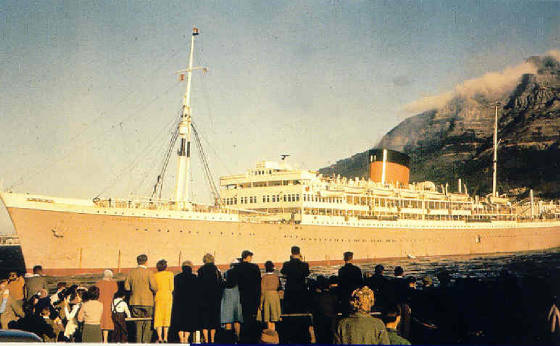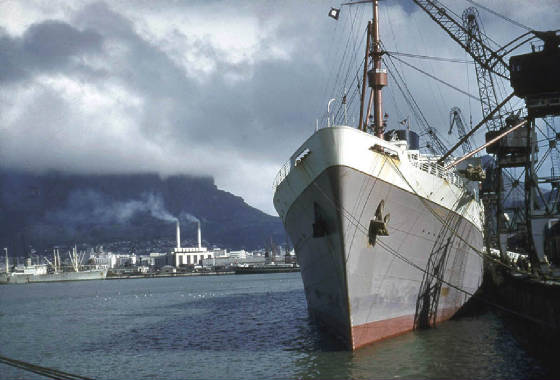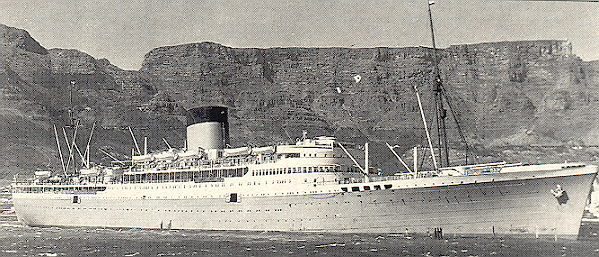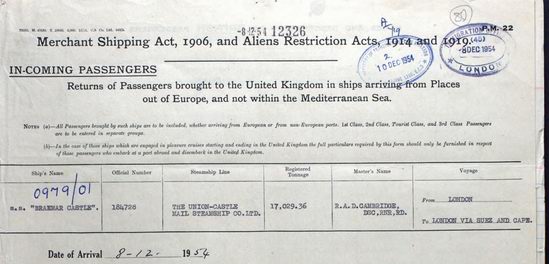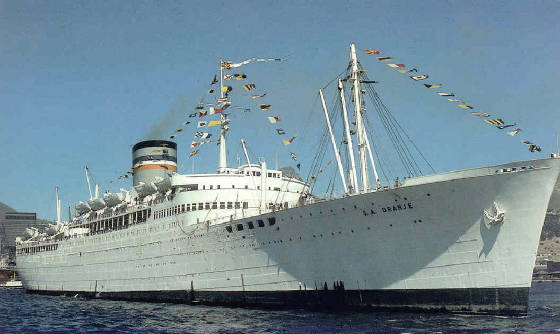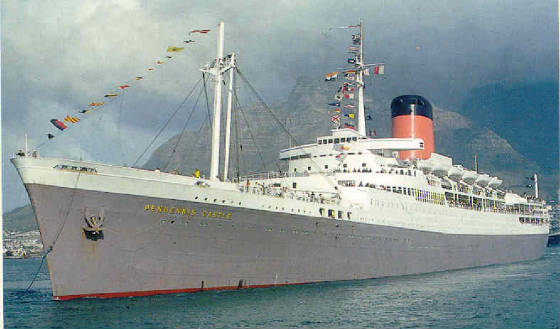 |
|
THIS PAGE ALSO INCLUDES THE CIRCUMSTANCES SURROUNDING THE FIRE ABOARD
THE "GOOD HOPE CASTLE" AS RELATED BY CAPTAIN PETER ASHCROFT IN ONE OF HIS MORE SERIOUS VEINS !.
The painting above is by Simon Fisher and is entitled 'CASTLES
AT THE CAPE'. Resplendant in the fondly remembered Union-Castle lavender-hulled colours, CAPETOWN CASTLE
passes EDINBURGH CASTLE in Capetown Harbour in the 50s, Table Mountain forming a fine backdrop.
The WINCHESTER and WARWICK CASTLE (sunk in WWII) were the only ships
rebuilt in 1930s to keep their original bows.
The
RMMV WINCHESTER CASTLE was built in 1930 by Harland & Wolff.
Of 20,000 grt (1939) she was 657 feet in length and
75.6 feet wide. Twin screw diesels provided a service speed of 20
knots. Her capacity was for 189 First and 398 Tourist
passengers.
The
second of two sister ships WINCHESTER CASTLE's 1938 refit for the
new mail contract resulted in more powerful diesels
installed, a single funnel replaced the original pair of squat ones but
unlike CARNARVON CASTLE, her bows were unaltered. As
with her fleetmates her war service was followed by a prolonged
use as a migrant ship to South Africa and it was not
until September 1949 that she resumed the Cape Mail.
ARUNDEL CASTLE's 37 years of service on the Cape Mail was without equal
as was her post-1938 appearance above.
She
was built by Harland & Wolff's of Belfast in 1921. She
was 19,118 grt (post-1937), 661 feet in length and 72
feet in width. Twin screws gave a service speed of 20 knots.
She held 168 First Class and 371 Tourist (post-50).
The
ARUNDEL was the Grand Old Lady of the mail fleet and was transformed
from a 4 funnel Edwardian profile (she and sister
WINDSOR CASTLE were the only four funnel vessels outside of the North
Atlantic) to a rakish two funnel, raked bow greyhound
in nine months at her builder's from January to October 1938.
New boilers, extended bows and new turbines upped her
speed from 16 to 20 knots. She was the last mailship to return
after the war following austerity emigrant service in
September 1950. Her 37 years 8 months on the Cape Mail was a record.
The
advertisement below appeared in travel agents throughout
the country enticing those young and ambitious enough
to rise to the challenge and emigrate to South Africa. Many were
offered assisted passages, especially the professions
which prospered greatly in the days of apartheid.
The
Union Steamship Company was formed at Southampton in 1853 and 4
years later the Line secured a mail contract to South
Africa. The well known 'Castle' naming policy was started by a
Donald Currie who initially traded to India in 1862.
The merged Union-Castle Mail Steamship Company was registered in
1900.
Crowds on the A-berth bullnose at Cape Town bid farewell to the 1926-built
CARNARVON CASTLE as she heads for Southampton.
She
was built in 1926 by Harland & Wolff of Belfast, of 20,141 grt
(1949) 686 feet in length and 73.5 feet wide, twin
screw diesels providing a service speed of 20 knots.. She carried
216 First and 401 Tourist passengers (post-50).
She
was also the first mailship to exceed 20,000 tons and the first
motor ship on the Cape run. CARNARVON CASTLE ushered
in the era of fast diesel-driven express liners on the route, In
1937, along with the rest of the fleet, she was
extensively rebuilt for the expedited mail contract with new more
powerful
diesels, lengthened and finer bows with a raked stem
and a single, large streamlined funnel amidships. Very much
a new ship, CARNARVON CASTLE resumed service in July
of 1938 and two months later the record passage to Cape Town of 11 days
21 hours which stood until 1954. After trooping and
post-war emigrant service, she was fully refitted and resumed the
Mail service on June 1950.
The
Union-Castle fleet consisted of not only the larger mail ships but
a series of 'intermediate' size vessels offering a
'Round-Africa' service. These included the BRAEMAR CASTLE,
DURBAN CASTLE, KENYA CASTLE, RHODESIA CASTLE,
WARWICK CASTLE and the little LLANSTEPHEN CASTLE. All
of approximately 17,000 gross tons. Their itinerary
would include Las Palmas, Ascension, St. Helena,
Capetown, Port Elizabeth, East London, Durban,
Lourenco Marques, Beira, Dar-es-Salaam,
Zanzibar, Tanga, Mombasa, Aden, Port Sudan,
Suez, Port Said, Genoa, Marseilles
and Gibraltar. A 'best' cabin onboard, with private
toilet and bath, cost 100 pounds for the three
and a half week voyage to Capetown.
Smaller
ships of the line were known as the 'fruit boats', the
itineraries of which included the Cape ports and the
East Coast, returning to the U.K. through Suez and the Mediterranean.
The CAPETOWN CASTLE, with the Blue Peter at the foremast, prepares to leave Southampton at 1600 Thursday (this was to change in 1965 due to the accelerated 11.5 day passage to 1300 Fridays) for yet another trip to South Africa. She will stop at Las Palmas on the southward journey and probably Madeira on the home run. Following her initial stay at Capetown she will continue around the coast to Port Elizabeth, East London and Durban. After a short stay in Durban she will head southwards for another longer stay in Capetown before the voyage home to Southampton. Seven lavender hulled ships comprised the Union-Castle mail service.
Ultimately jet travel and containerisation of the South African cargo trade led to the end of this service.
The
picture of the STIRLING CASTLE above emphasizes the
'yacht-like' profile of the CAPETOWN, STIRLING and
ATHLONE CASTLE. Although built in the thirties these three
vessels portrayed an aerodynamic design ahead of their
time.
The
EDINBURGH and the PRETORIA CASTLE were the two larger vessels and
were arguably the 'best' of the liners and it seemed
that everyone wanted to travel in them. They carried 214 in 1st
Class and 541 in Tourist. By the mid-seventies the
Union-Castle liner runs were losing money. While all of the
pre-war liners had been retired there was a joint
effort with the South African Corporation (Safmarine Lines) to continue
the service but further decline lay ahead. In
1975-76 the older EDINBURGH CASTLE and, what had become the SA
ORANJE (ex PRETORIA CASTLE), were retired and sold
to Far Eastern breakers.
Launched
as PRETORIA CASTLE on August 19th. 1947
by Mrs. Issie Smuts, the wife of the then Prime
Minister of South Africa, Union-Castle Line's 28,705 grt mailship was
sold to Safmarine in 1966 and three years was
transferred to South African registry. Renamed S.A. ORANJE, she
served with Safmarine until 1975 when she was sent to
Taiwan for demolition.
Above, PENDENNIS CASTLE, after only 17 years of service, departs Cape Town for the last time in June of 1976. She was built in 1958 by Harland & Wolff, of 28, 453 grt, 763 feet in length and 84 feet wide. Twin screw turbines provided a service speed of 23 knots. She carried 167 First and 475 Tourist passengers. In "Mailships of the Union-Castle Line" the PENDENNIS was arguably the best mailship built and she was the fastest of the fleet. For the first time a mailship had stabilizers which required a lengthening of the hull from 748 to 763 feet on the stocks. The accommodation layout marked the first departure since the 1930s but she was the last major passenger liner built that was not entirely air-conditioned. The inspiration for interiors conveying 'tranquility and airy spaciousness' came from Bernard Cayzer, youngest brother of Chairman Sir Nicholas, who engaged the famous interior designer Jean Munro. When refitted in 1964, all First Class cabins were air-conditioned and 21 more cabins were given private facilities. WINDSOR
CASTLE was the largest British-built liner since the QUEEN
ELIZABETH when she came out. She reflected the 1960's
trend towards so-called 'superliners' offering unprecendented
size, speed and amenities to compete with growing air
competitiion. She was the largest liner ever built
for the Cape run and, after ORIANA and CANBERRA, the
largest non-North Atlantic liner built post-war.
For the first time on the Cape run there was entirely air-conditioned
accommodation, a permanent 246 seat cinema and 'stem-to-stern' Tourist Class facilities on 'A' deck.
Equally
impressive was her cargo carrying capacity totalling 352,000
square feet reefer, 271,000 sq. feet general cargo
and a 26 car garage. In 1968 she was fitted with special bulk
wine tanks (capacity 81,000 gallons) for the booming
South African wine export industry.
| |||||||||||||||||||||||||||||||||||||||||||||||||||||||||||||||||||||||||||||||||||||||||||||||||||||||||||||||||||||||||||||||||||||||||||||||||||||||||||||||||||||||||||||||||||||||||||||||||||||||||||||||
UNION-CASTLE LINE
|

